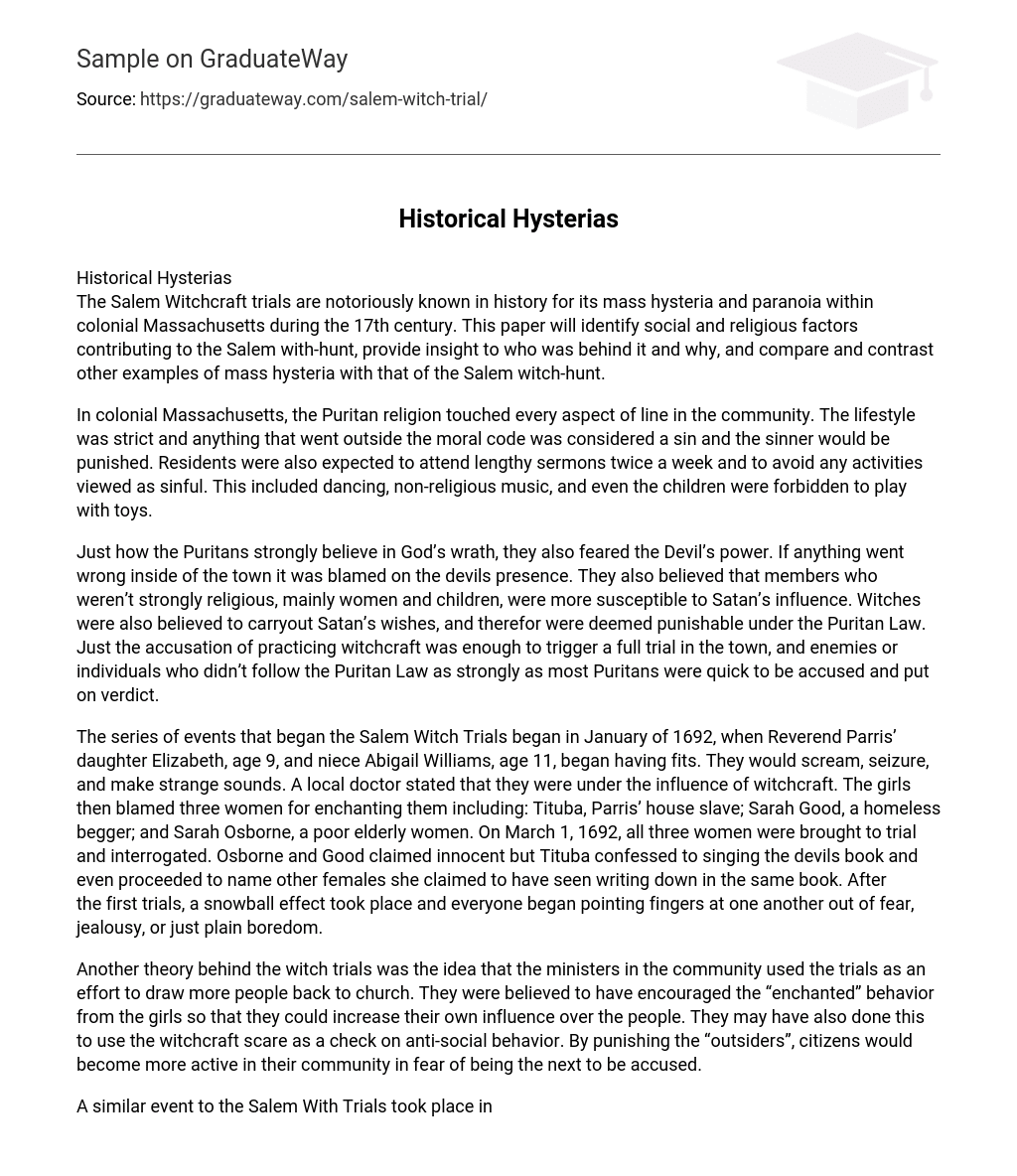The Salem Witchcraft trials are notoriously known in history for its mass hysteria and paranoia within colonial Massachusetts during the 17th century. This paper will identify social and religious factors contributing to the Salem with-hunt, provide insight to who was behind it and why, and compare and contrast other examples of mass hysteria with that of the Salem witch-hunt.
In colonial Massachusetts, the Puritan religion touched every aspect of line in the community. The lifestyle was strict and anything that went outside the moral code was considered a sin and the sinner would be punished. Residents were also expected to attend lengthy sermons twice a week and to avoid any activities viewed as sinful. This included dancing, non-religious music, and even the children were forbidden to play with toys.
Just how the Puritans strongly believe in God’s wrath, they also feared the Devil’s power. If anything went wrong inside of the town it was blamed on the devils presence. They also believed that members who weren’t strongly religious, mainly women and children, were more susceptible to Satan’s influence. Witches were also believed to carryout Satan’s wishes, and therefor were deemed punishable under the Puritan Law. Just the accusation of practicing witchcraft was enough to trigger a full trial in the town, and enemies or individuals who didn’t follow the Puritan Law as strongly as most Puritans were quick to be accused and put on verdict.
The series of events that began the Salem Witch Trials began in January of 1692, when Reverend Parris’ daughter Elizabeth, age 9, and niece Abigail Williams, age 11, began having fits. They would scream, seizure, and make strange sounds. A local doctor stated that they were under the influence of witchcraft. The girls then blamed three women for enchanting them including: Tituba, Parris’ house slave; Sarah Good, a homeless begger; and Sarah Osborne, a poor elderly women.
On March 1, 1692, all three women were brought to trial and interrogated. Osborne and Good claimed innocent but Tituba confessed to singing the devils book and even proceeded to name other females she claimed to have seen writing down in the same book. After the first trials, a snowball effect took place and everyone began pointing fingers at one another out of fear, jealousy, or just plain boredom.
Another theory behind the witch trials was the idea that the ministers in the community used the trials as an effort to draw more people back to church. They were believed to have encouraged the “enchanted” behavior from the girls so that they could increase their own influence over the people. They may have also done this to use the witchcraft scare as a check on anti-social behavior. By punishing the “outsiders”, citizens would become more active in their community in fear of being the next to be accused.
A similar event to the Salem With Trials took place in the 1950s with Senator Joe McCarthy. During what was known as the Red Scare when the senator claim to possess a list of 205 State Department employees who were known Communist moles. This was after World War II when Russia was rising to power and the fear of communist was fresh in very American. Instead of giving his alleged list to the FBI for investigation, McCarthy chose to hold Congressional hearing to investigate the claims personally.
A panic spread throughout America just like in the Salem Witch Trails. Everyone quickly began to suspect his or her family and friends as hidden communist, with little to no evidence. Although there were no deaths, many were blacklisted until it had been clear that the list was fraud. This is just another example how mass hysteria can steer a community out of control.
Another historical event similar to the tragedies of the Salem Witch Trials was the massacre of Jews in the Holocaust. Although on a larger scale, the Holocaust shows as a constant reminder of the impact of mass hysteria, and share many similiarities as the Salem witch trials. In both events, the homeland lost a significant amount of innocent lives and many families were ruined.
Just as Hitler tried to gain power and respect by focusing all negatively on the Jews, the girls of the Salem Witch Trials tried to gain attention and popularity by accusing the towns’ people they didn’t like. Both regions tried to solve their social and economic problems by placing the blame on an irrelevant force. Hitler made it seem as if it were the Jews fault for Germany losing World Was I and going into a depressions, while
ministers in the Salem Witch Trials blamed the devil for their towns hardships, both rallying their citizens together to feed on the fear of each other and rely on their leaders for guidance.
In conclusion, mass paranoia and hysteria have the potential to weaken and possibly tear apart a nation. This paper has identified how the strict Puritan lifestyle contributed to the Salem Witch Hunt, shows the theories of the ministers involvements and the young girls roles behind the start of trials. It has also, compared and contrasted past historical events that share the same hysteria as the notorious Salem Witch Trials.
Work Cited
- “Salem Witchcraft Trials 1692” http://law2.umkc.edu/faculty/projects/ftrials/salem/salem.htm
- “Religious Aspects” https://www.msu.edu/~shahfaiz/Salem/religion.html
- “Salem Witch Trials” https://totallyhistory.com/salem-witch-trials/
- “SALEM WITCH TRIALS OF 1692” https://www.witchway.net/times/salem.html





